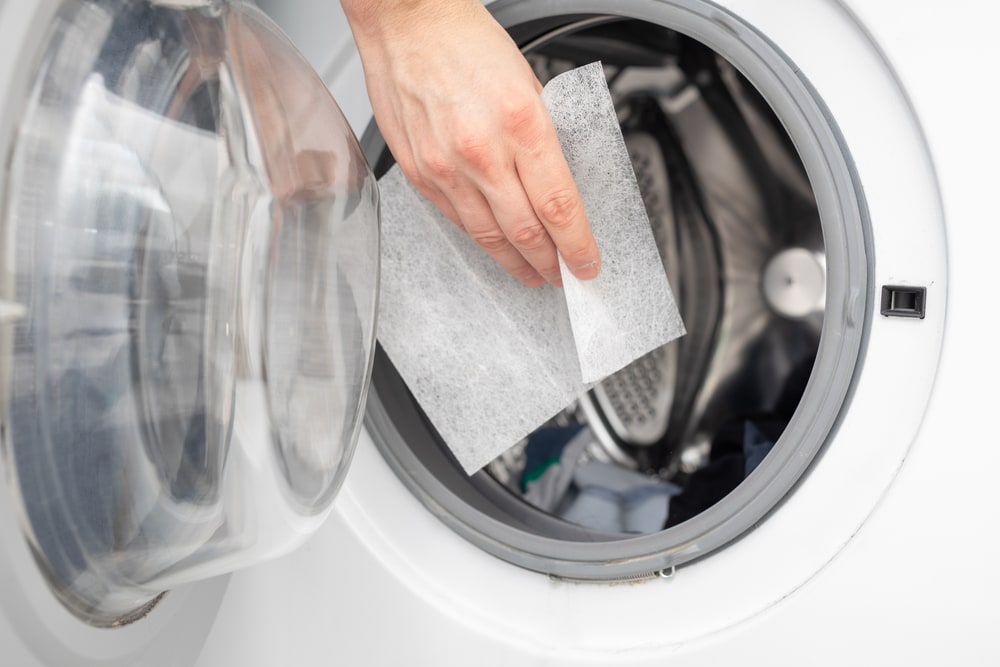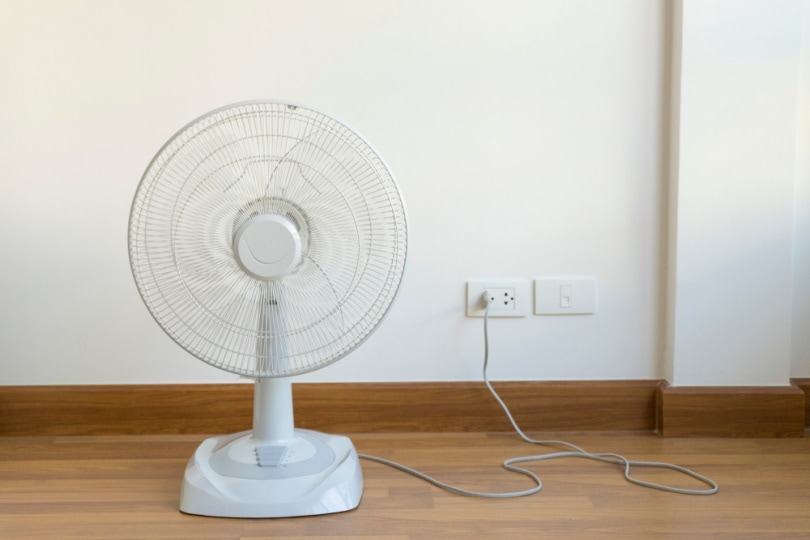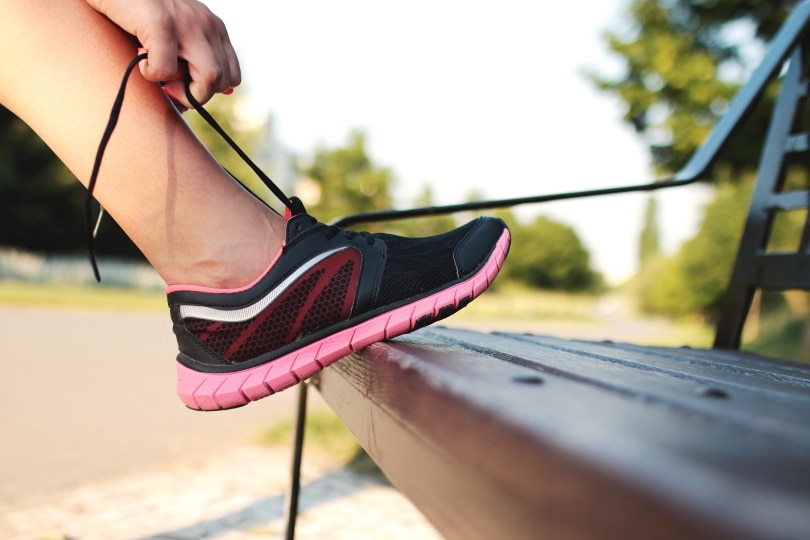Can You Put Shoes in the Dryer? Facts & FAQ
-
- Last updated:

Dryers play an essential role in our lives. These mighty household machines do a great job squeezing the moisture out of our clothes, bed sheets, and even curtains. But what about shoes, though? Can you put a pair of sneakers or slippers in a dryer?
Unfortunately, no. Most likely, the machine will mess up the glue or adhesive. Secondly, it will cause the shoes to warp/shrink.
But wait—does this apply to every single shoe type? What are the best alternatives to dryers? Will a rack work? Do washing machines and shoes go well together, or not? These are just some of the questions we’ll answer in this guide.
So, let’s learn how we can get those sandals and boots dry!

What Is a Dryer?
As the name suggests, a dryer has one purpose: to dry whatever you put in it. And while the market is overwhelmed with two-in-one appliances (washer + dryer), there are lots of standalone dryers in American households. They take up extra space in the laundry room, but they also get the job done faster. On top of that, dryers have a higher loading capacity.
A “classic” vented dryer relies on three forces: thermal, rotational, and frictional—heat, motion, and air. The heating part comes from electricity (but can also be gas/propane). The metal coins inside of the dryer get heated and warm the air. Next, the hot air circulates inside the rotating drum that contains all the wet clothes. At the end of the cycle, the air escapes the dryer through dedicated vents.
Different Types of Dryers

Vented systems aren’t the only option on the market. Before we talk about the biggest reasons for keeping your shoes away from dryers, here’s a quick look at what the market has to offer today:
- Heated pump. These machines absorb all the water/moisture from the clothes using hot air. Heat-pump units are quite effective and reliable. On top of that, they are energy-efficient, long-lasting, and easy to use, not to mention they come packed with a wide range of features and settings. On the downside, they aren’t particularly cheap.
- Mobile, lightweight, and user-friendly, condenser dryers do just that: condense the steam inside of the drum and convert it into liquid water. There’s a container installed into the machine that holds all that water. These dryers are reasonably priced and rather fast.
- For this dryer to work, it needs to be installed next to a window or a door. Otherwise, it won’t be able to effectively get rid of the hot and humid air collected from the load in the drum. Vented dryers have been around for many decades and are today considered the least favorable pick. They are quite affordable, though.

So, Are Dryers Safe for Shoes or Not?
Unless you want the drum to do a number of your shoes, don’t put them in a dryer. Even if you’re the proud owner of brick-strong sneakers that easily handle water, sunlight, dust, and temperature spikes, they won’t be able to make it through this “rollercoaster” scot-free. The adhesive used to keep the shoes together will fail first.
Next, depending on the quality of the fabric, the shoes will shrink and become too small for your feet. In the worst-case scenario, your kicks will warp under the pressure. That will render them useless or, at the very least, impact their performance and the way they fit. That’s why it’s generally not recommended to use a dryer on shoes even if you’re in a hurry.
Do Drying Racks Work?

Drying racks are specifically designed for shoes. However, while they might work on some materials, you still can’t be 100% sure they won’t damage your sneakers, boots, or whatever you put in there. If you still want to try this, only “feed” the dryer with canvas- or cotton-made sneakers. Next, wash the shoes, remove the lint, and fill the shoes with rags/towels. The heat settings need to be turned all the way down to protect the shoes.
Before you hit the “power” button, put a bunch of towels inside the drying rack. They’ll absorb some of the moist air coming out of the shoes. Now just untie the laces and start the rack up. The same technique can be used with a regular dryer (at your own discretion), but only if the shoes don’t touch the drum. Otherwise, they’ll hit the walls with every spin, making a loud noise and wearing out.
- Grab the laces and pull the shoes to the front of the dryer
- To secure the shoes, hold the laces up and slam the door
- Start the machine; make sure it’s set to low heat
What Are the Best Alternatives to a Dryer?

There are three tried-and-true ways of removing moisture from shoes without “torturing” them with extreme heat and a drum that spins at the speed of light. True, you can always hang the sneakers from a door, but that will take more time.
- The old-school newspaper technique. Just fill each shoe with a piece of newspaper (put as much of it in there as you can for maximum efficiency) and give it some time to absorb all the moisture. Replace it with new, fresh paper every 2–3 hours. Keep doing it for 10–12 hours to dry the shoes. Wrapping the shoes with newspaper/soft towels will speed up the process. And, you can stuff them with rice.
- Use a fan to dry the shoes. First, turn the fan on. Next, find a way to keep the shoes right in front of it to absorb all that cold air. One way to do that is to hang them from the fan using a piece of wire. To make sure the shoes don’t deform/warp, put a piece of cloth or a towel inside of each shoe. The fan will have the shoe moisture-free in a couple of hours. A fridge or an air vent will also work, by the way.
- Invest in a boot dryer. In contrast to regular dryers or dryer racks, these machines are a lot less aggressive. The concept is the same (the dryer blows air inside of the shoes) but, again, boot dryers are generally safe because the air isn’t heated. The option is there, but you don’t have to activate it for the dryer to be efficient.
And one more thing: keep your shoes away from direct sunlight, as that can lead to wear and even warping. Instead, put them in the driest and most-ventilated spot in the house.

Keeping Shoes Dry: Why Does It Matter?
Do you know why sneakers get dirty? The #1 reason for that is human sweat. True, there’s also all that dirt, dust, pollen, mud, water, and whatnot from the outside, but sweat is still the biggest problem here. Now, on top of making the shoes look and smell funky, sweat serves as a breeding ground for bacteria and fungi. The only way to successfully battle that is to keep the shoes dry.
Wearing one single set of kicks for many days (or even weeks) in a row won’t let them air out properly. Make a habit of switching to a different pair once in a while to keep fungi growth to a minimum. We also recommend switching from leather to a breathable fabric like silk, nylon, or cotton. If you skip this part, you’ll end up with smelly shoes that look bad and threaten your feet’ health.

Is Machine Washing an Option for Shoes?
In contrast to popular belief, certain types of shoes can survive a “one-on-one” with a washing machine. It all comes down to the material. For example, leather, suede, silk, and wool shoes are not a good match for a laundry machine. In contrast, polyester, spandex, cotton, or nylon is an entirely different story.
Check what your footwear is made of before putting it into the washer to avoid unwanted consequences. This doesn’t apply to the laces and the insoles, though. With laces, you can still wash them in a machine as long as you put them in a bag. The insoles, however, have to be cleaned by hand because they’re quite delicate.

Conclusion
For a person who’s used to drying clothes manually, a dryer is a life savior. These machines are highly efficient and reliable and only take 30–45 minutes to get the job done. However, while they are designed to “handle” a wide range of fabrics, dryers don’t necessarily go well with shoes. Technically, they will dry the sneakers.
But they’ll also damage the adhesive and deform the shoes. Even if you set the dryer to low heat or go with a rack, that still won’t guarantee a happy outcome. Fortunately, there are other options on the table. While they might take more effort, it’s always better to go slow instead of ruining an expensive set of kicks!
- Related Read: How to Wash Shoes in A Washing Machine in 4 Simple Steps
- HowStuffWorks – How Clothes Dryers Work
- Our expert guide to buying a tumble dryer
- Give Up the Funk – How to Clean Shoes in the Washer
- A Beginners Guide to Machine Washable Fabrics
- How To Dry Wet Shoes Easily And Perfectly With Newspaper
- The 2 Best Ways to Dry Your Shoes Without Damaging Them
- 10 Most Important Steps to Know How to Dry Shoes In the Dryer!
- How to Dry Shoes Quickly – Tips and Tricks
Featured Image Credit; Ana Belen Garcia Sanchez, Shutterstock
Contents

